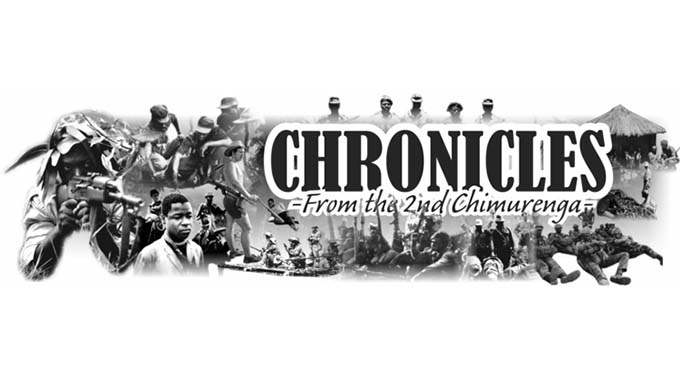
The Sunday Mail

Chronicles of the Second Chimurenga
I’m still haunted by Nyadzonya
ONE of the gloomiest incidents during Zimbabwe’s liberation struggle was the Nyadzonya attack, which was executed by Rhodesia’s dreaded Selous Scouts under what they code-named Operation Eland in August 1976. More than 1 000 ZANLA cadres, most of whom were unarmed, were reportedly killed. Cde ROBSON MOYANA (RM), whose Chimurenga name was Cde Nhamo yeZimbabwe, was one of the defenceless ZANLA trainees who survived the attack. He tells our Political Editor KUDA BWITITI (KB) how he joined the liberation struggle and how he escaped from the bloodbath at Nyadzonya.
******************
KB: May you kindly introduce yourself.
RM: My name is Robson Moyana. I was born on June 20, 1950 in Mutare, at Jena Hospital. I grew up in Mutare and went to Sakubva Primary School.
KB: At what point did you start to consider joining the liberation struggle?
RM: In the late 1960s to the early 1970s, I was a young man and I suffered the segregation that black people faced under Ian Smith’s colonial government. As such, a lot of young men and women were crossing into Mozambique to join the liberation struggle to fight for majority rule. Sometime towards the end of 1975, I also answered this call and made the decision to join the fight for independence.
KB: Take us through the day you set off for this mission.
RM: I lived in Mutare and it was pretty easy to cross into Mozambique. The decision to cross into Mozambique is something that I had been mulling over for some time with my colleagues. There were many of us eager to fight the war. I particularly remember that our travelling party included some young girls who had decided to leave school to join the war.
We walked for a couple of days. Along the way, we met some Frelimo cadres and they helped us find our way to Nyadzonya. Upon arrival at Nyadzonya, the first thing was to work as security officers at the camp. This was the procedure every new cadre had to go through as part of the integration process. We were then grouped into specific companies. I was in a company called Dubhula and stayed there for several months.
KB: What do you remember most about Nyadzonya Camp?
RM: Most cadres at Nyadzonya had received light training, which included cover-and-crawl tactics. The bulk of us also did not have any weapons. Word began to spread that one of our section commanders had turned traitor. So, we were advised to be on the lookout. We were even advised to treat with caution any armoured vehicles that would come into the camp under the pretext of wanting to take comrades to Tanzania.
KB: Please describe what happened on the day of the Nyadzonya attack — August 9, 1976.
RM: We started with our normal routine, which was to go for the morning parade. Nyathi knew that we would all be gathered at the parade at 8 o’clock in the morning. We were toyi-toying when one of our comrades raised the alarm after noticing some men approaching us. He was quick to notice that they were white men, but had covered their faces with masks. When he screamed about the looming danger, he was gunned down at point-black range, and we knew that trouble had started.
I fled as the Selous Scouts were fast approaching. The enemy was heavily armed; they had machine guns and armoured vehicles. The worst part about this attack was that one of our own, Nyathi, was actually giving directions to the Rhodesian soldiers, telling them about the various locations where they would find us.
He had all the intelligence concerning our camp. At first, the cover-and-crawl tactic was effective in our attempts to flee from the enemy, who were shooting at the hip level. However, the enemy soldiers changed their tactics and aimed lower. Many comrades lost their lives as they tried to flee.
KB: How did you manage to survive?
RM: At Nyadzonya, there was a nearby river named after the place. Since I had mastered the cover-and-crawl tactic, I got to Nyadzonya River before the enemy could aim at me. But it was a massive tragedy. I saw body parts falling off from comrades who would have been shot.
I saw a number of our female cadres dead, with limbs separated from the body. This shows you the power of the weaponry they used against our largely defenceless group. It was horrific, and it is something that still disturbs me even today.
KB: What followed after you survived the attack?
RM: We regrouped and made the journey to Masengere Camp and stayed there with Frelimo comrades. Not long after that, a new camp named Doroi was formed. I was part of the team that constructed Doroi Camp. We started with construction of the structures for the security team. We then built a clinic and barracks. Before we built the barracks, we used to sleep in the open. You would just find a tree and sleep under it, with blankets donated from organisations such as the United Nations. This was how we lived at Doroi Camp at first.
KB: For how long did you stay at Doroi?
RM: We stayed for quite some time, until 1977. That year, many comrades were recruited to go for training in Tanzania. During the first intake, I was not selected because I had to remain in the security department.
That first intake, which I missed, was commonly known as Fanya Haraka, a Kiswahili term that means hurry up. They travelled in trucks. When my turn to go to Tanzania came, we used a Nigeria Airways plane. We arrived at Chingweya Airport and were picked up by some vehicles. I was deployed to Regiment 8. This was the base where I attained advanced military training, with assistance from Tanzanian soldiers. During that process, I managed to also learn some Kiswahili.






